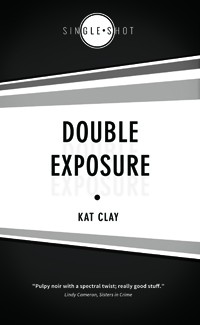 Written by Kat Clay — Australia’s Crime Factory has been publishing novellas alongside their magazine for a couple of years now. Last year we reviewed two of them, Jake Hinkson’s Saint Homicide and Ed Kurtz’s Freight. Though very different books they were both fine examples of modern noir. Double Exposure, by Melbourne photographer and journalist, is a different beast.
Written by Kat Clay — Australia’s Crime Factory has been publishing novellas alongside their magazine for a couple of years now. Last year we reviewed two of them, Jake Hinkson’s Saint Homicide and Ed Kurtz’s Freight. Though very different books they were both fine examples of modern noir. Double Exposure, by Melbourne photographer and journalist, is a different beast.
The Photographer – no name is ever given – works the back rooms of fictional Portvieux City, capturing the rich and famous with their pants down or their skirts up. No scandal is too prurient for his employers at the city’s scandal rag, City Secrets. In his earlier days the Photographer aspired to more artistic work, but his stint as an army photographer in World War II has left him without such ambitions. His first assignment is to a boarding house where a murder has been committed. Beating the cops to the scene he discovers a room covered in fresh blood but without a victim. Yet when he sets up his shot he can see a corpse through the viewfinder of his Hallidax camera. A woman lies on her back, dead eyes looking into him in a pose that is strangely familiar.
Before he can return to get his film developed and see if the image of the lady has been captured in the negative the Photographer is sent on another job. The crime scene in 1948 Portvieux is controlled by the Marne family, and the son James is being tried for the murder of three henchmen. Despite their criminal reputation being well established, the family have a habit of escaping justice and it surprises no-one when James Marne is acquitted. The Photographer once met his beautiful sister, Loretta, before the war when he took her debutante photo and she recognises him as he takes her picture on the courthouse steps. She too has an interest in photography and the pair arranges to meet again at the Marne summerhouse.
That night our man develops the day’s film and the victim’s image has been captured. He recognises her from a collection called Underhill’s Girls. Absalom Underhill was a local artist who achieved national success before disappearing. He photographed naked woman in a classical Greek style and named them after ancient myths. This girl was Innocence.
As he delves into Underhill’s background and the circumstances of his disappearance he discovers there are two large local collectors of Underhill prints, the Hallidax family that manufactured the cameras he uses, and the Marnes.
There is a second murder and the police remain baffled. Another room is drenched in blood, with no victim. Only when the photographer looks through his viewfinder can he see who has been killed. This time it is the model that played Memory, only with a stake through her heart. The photographer does not know if he is going mad. He is beginning to see the victims he pictured during the war haunt his waking hours. Perhaps he is in possession of a special camera, with some connection to the one Underhill used.
Double Exposure is a fascinating story. There are plenty of old fashioned noir stylings – the scandal rag scenes which reminded me of James Ellroy’s LA Confidential, and the femme fatale, but Clay takes her novella into the realms of weird fiction. The story is increasingly disorientating as the Photographer moves in and out of realities chasing a killer recreating images out of the past. A story like this has to be fully committed to, luckily it is something I especially enjoyed but readers who like more straightforward crime fiction may find it frustrating.
For more 1940s crime fiction, click here.
Crime Factory
Print
$10 (Australian) plus P&P
CFL Rating: 4 Stars
You can order Double Exposure here.







